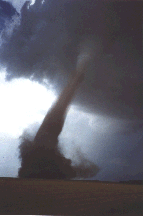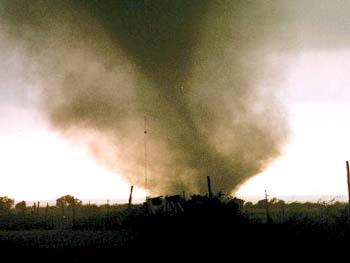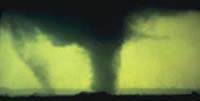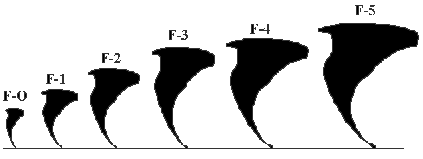Tornado Safety Tips
Lincoln University Police Department 
Tornado Safety Tips
At Home : Schools, Hospitals, Nursing Homes, and Office Buildings : In the Open : Fujita - Pearson Tornado Scale : Long Span Buildings : On the Road : Portable Classroom/Building

The University receives its tornado watches and warnings from the local television and radio stations. Jefferson City's warning sirens can be heard throughout campus. If the sirens are activated, students and employees should take immediate shelter in basements , move to interior hallways away from windows , or in secure stairwells. Public Safety officers do not go from building to building giving instructions or coordinating evacuations to safe areas. You must heed the warning independently and move to a safe area on your own. The Jefferson City all clear sirens will alert you when it is safe to return.

Tornadoes are nature's most violent - and erratic - storms. A tornado can travel for miles along the ground, lift and suddenly change direction and strike again. There is little you can do to protect your home or workplace from the strength of tornado winds, but there are actions you can take to protect yourself and your family better.
Tornadoes are formed by severe thunderstorms, most frequently in the spring and summer. If you live in a tornado-prone area, stay alert during severe weather.
Know your community's warning signals. Most often warnings will be given by local radio and television stations and by NOAA Weather Radio. In addition, some communities have sirens or whistles to warn of natural disasters.
Basic Safety Rules:
- Keep alert to changing weather conditions.
- Take shelter immediately when you hear a tornado warning or see a funnel cloud.
- Know where your shelter is before you need it.
Watches and Warnings

WARNINGS – The hazard (tornado, flash flood, etc) is imminent. The probability of occurrence is extremely high. Warnings are issued based on eyewitness reports or clear signatures from remote sensing devices such as radar and satellite. Lead-time for thunderstorm type events is generally 30 minutes or less.
WATCHES – Meteorologists have determined that conditions appear right for the development of the hazard. The probability of occurrence is greater than 60% in the watch area. Watches generally cover larger areas than warnings. In the case of thunderstorms, less than 30% of the watch area may experience the hazard. Severe thunderstorm and tornado watches are usually issued 1 to 2 hours before the event begins.
ADVISORIES - An advisory is issued for weather that is expected to be a disruption to the normal routine and an inconvenience, but it is not expected to be life-threatening.
What to Do if You are In a Residence Hall?
Residents must proceed to the basement of those residence halls that have one, or the hallways on the 1st floor of residence halls without a basement. Most, if not all hall lounges have windows. Know what your residence hall severe weather plan is ahead of time. Follow the instructions of hall personnel and don't leave the building until the all clear is given.
What to Do if You are In Class?
When the storm warning sirens sound, it is best Not to leave the building. Obviously, it is better to seek shelter in a basement. If the building you are in has no basement, or there is no building nearby with a basement, go to the lowest floor and get into a small interior room or hallway. Stay away from glass and exterior walls; put as many walls between you and the storm as you can.
What to Do if You are In a Gym or Auditorium?
DANGER! Large, open-span areas, such as gymnasiums, auditoriums, and most lunchrooms, can be very dangerous even in weak tornadoes, and should not be used for sheltering people. This sort of room has inherent structural weaknesses with lack of roof support, making them especially prone to collapse with weaker wind loading than more compact areas of the same school building.
At Home
Get to shelter immediately. AVOID WINDOWS. Flying glass can injure or kill. Don't open windows. Houses don't "explode" and allowing strong wind in can do damage or cause injury. The safest place in the home is the interior part of the basement, preferably under something sturdy like a table. Stay out from under heavy objects like pianos or refrigerators in the floor above. If you have no basement, go to an inside room on the lowest floor, like a closet, hallway, or bathroom with no windows. For added protection, get under something strong, like a workbench or heavy table. If possible, cover your body with a blanket or sleeping bag and protect your head with anything available, even your hands.
Portable Classrooms/Buildings
Portable classrooms are most often constructed like mobile homes; and they are just as dangerous. Any sound tornado safety plan must include getting students out of portable classrooms and into a safe area in the main building, as quickly as possible, to minimize the time spent outside and exposed to the elements. While the seconds spent outside will pose considerable risk, the danger inside the trailer is just as great. If feasible, students should be evacuated from portable classrooms before the storm threatens -- before the warning, when a tornado or severe thunderstorm watch is issued. Remember: Tornadoes can occur with little or no advance warning.
On the Road
The least desirable place to be during a tornado is in a motor vehicle. Cars, buses, and trucks are tossed easily by tornado winds. Do not try to outrun a tornado in your car.
If you see a tornado, stop your vehicle and get out. Seek shelter away from the car in a nearby ditch or ravine. Don't take shelter under your vehicle. Lie flat in a ditch or ravine and put your arms over your head.
Long Span Buildings
Long span buildings are dangerous. The entire roof structure is supported solely by the outside walls. Inside walls are usually false or non-load bearing walls.
If you are caught in a open building like a shopping mall, civic center, indoor pool, theater, or gymnasium during a tornado, stay away for windows. Get into the restroom, if possible. In larger buildings the restrooms are usually made from concrete block. Besides having four walls and plumbing holding things together, metal partitions help support any falling debris. If there is not time to go anywhere, seek shelter right where you are. Try to get up against something that will support or deflect falling debris. For instance, in a department store, get up against heavy shelving or counters. In a theater, get under seats. Remember to protect your head.
Schools, Hospitals, Nursing Homes, and Office Buildings
Extra precautions are needed in these structures. Not only is there a large concentration of people in a small area, but these buildings usually have large amounts of glass on the outside walls. Get into the innermost portions on the lowest floor possible. Avoid windows, glass doorways, and auditoriums and cafeterias not protected by overhead floors and rooms. Do not use elevators; the power may go off and you could become trapped. Protect your head and make yourself a small target as possible by couching down.
In the Open
If you are caught outside during a tornado and there is no underground shelter immediately available, lie in a gully ditch, or low spot in the ground. Protect your body and head with anything available. Do not go into a grove of trees or under a vehicle.
Emergency services personnel are usually on the scene quickly after a tornado. Keep your family together and wait for help to arrive. Listen to the radio for information about disaster relief and volunteer agencies.
If you are outside, do not go into damaged buildings; they may collapse completely. Wait for help to search for others. If your home appears undamaged, check carefully for gas or other utility line breaks. If the lights are out, use a flashlight only; do not use a match, lighter, or any open flame.
Fujita - Pearson Tornado Scale
F-0: 40-72 mph, chimney damage, tree branches broken
F-1: 73-112 mph, mobile homes pushed off foundation or overturned 
F-2: 113-157 mph, considerable damage, mobile homes demolished, trees uprooted
F-3: 158-205 mph, roofs and walls torn down, trains overturned, cars thrown
F-4: 207-260 mph, well-constructed walls leveled
F-5: 261-318 mph, homes lifted off foundation and carried considerable distances, autos thrown as far as 100 meters
Remember, there is no such thing as guaranteed safety from a tornado. Freak accidents happen; and the most violent tornadoes can level and blow away all but the most intensely fortified structures. Extremely violent EF5 tornadoes are very rare, though; and even within one's path, only a small area has EF5 damage. Most of any tornado's damage track is actually much weaker and can be survived using sound safety practices.
